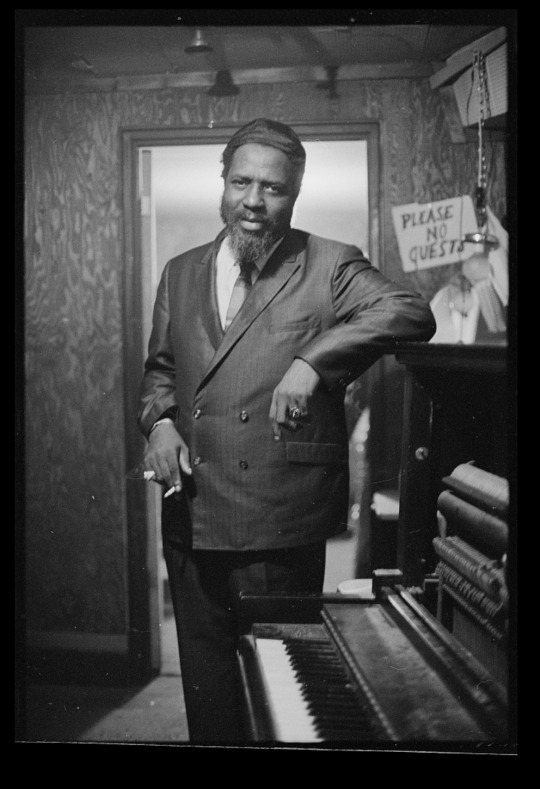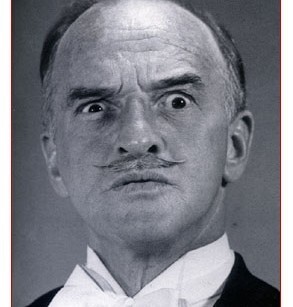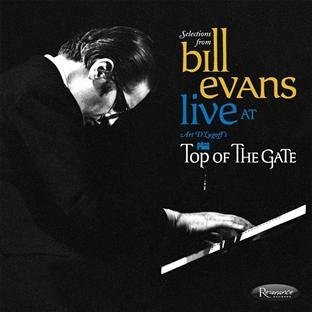#Art d'Lugoff
Text




1962.
Thelonious Monk at the Village Gate
19 notes
·
View notes
Text

I used to make the rounds of the bars—Julius’s for those fat hamburgers on toast, then the San Remo, the Kettle of Fish, and the White Horse. Booze was a social thing. The bar scene wasn’t just to get drunk. It was like the public square in a town or a sidewalk café in Paris—comradely meeting and talking.
—Art d’Lugoff, founder of the Village Gate nightclub, about the 1950s in Greenwich Village
Photo: 1955, by Marvin E. Newman via the Stephen Daiter Gallery
#New York#NYC#vintage New York#1950s#bar scene#Marvin E. Newman#bars#Greenwich Village#cafes#Art d'Lugoff#vintage Greenwich Village
71 notes
·
View notes
Text
3000 Beatniks Riot

Half a century before Occupy Wall Street, young protesters occupied Greenwich Village's Washington Square Park. Like OWS, they ended up clashing with the police. Unlike OWS so far, their protest produced a small but practical and lasting change.
In the spring of 1961, the Washington Square Association, a community group of homeowners around the square, appealed to New York City's Department of Parks and Recreation to do something about the hundreds of "roving troubadours and their followers" playing music around the square's turned-off fountain on Sunday afternoons. They were mostly college kids, playing guitars and banjos and singing folk songs. The practice had started in the post-war years, when Woody Guthrie and Pete Seeger planted the seeds of the folk musical revival in the Village. By 1961 it had grown enough that both the police and the neighbors found the "troubadours" and the tourists they attracted a nuisance. In his posthumously-published memoir, Dave Van Ronk recalls that there were various cliques in the park: a Zionist group singing and dancing "Hava Nagila," Stalinists, bluegrass fans, folk traditionalists. Black journalist John A. Williams reported that the locals' complaints were not really musical but social: "In the ensuing meetings with city officials, it became apparent that what was opposed was not so much folk singing as the increasing presence of mixed couples in the area, mostly Negro men and white women." In the late 1950s the parks commission began issuing permits to limit the number of musicians, allowing them to "sing and play from two until five as long as they had no drums," Van Ronk writes. This "kept out the bongo players. The Village had bongo players up the wazoo... and we hated them. So that was some consolation." He doesn't mention that those bongo-players were very often black. This racial aspect had an old historical precedent in Greenwich Village. In 1819, white residents of the area complained "of being much annoyed by certain persons of color practising as Musician with Drums and other instruments through the Village."
In 1961 the parks commissioner responded to the complaints by refusing to issue any permits at all. Izzy Young of the Folklore Center and others organized a peaceful protest demonstration. On Sunday, April 9, 1961, a few hundred young people gathered, attracting a few hundred more spectators. Among the latter was eighteen-year-old Dan Drasin, a mild-mannered kid who liked to hang out in the park. He brought one of the big, boxy film cameras of the era and documented the afternoon in a short black-and-white film, Sunday. The film shows clean-cut college and high school kids, many of the girls in Jackie O hairdos and heels, many of the boys looking like the young Allen Ginsbergs with serious, sensitive, owlish faces behind heavy black-framed glasses. They carry hand-written placards and cardboard guitars and argue with the dozens of beefy, florid-faced cops who've shown up. Izzy Young, also bespectacled and in jacket and tie, lectures the cops about the constitutional right to make music as the kids sit in a circle in the dry fountain and sing "This Land Is Your Land" and "The Star-Spangled Banner." As protests go it all looks low-key and polite. Then paddy wagons arrive and the cops haul off one nebbishy young man cradling an autoharp, pushing him into a prowl car. According to Drasin, most of the singers and musicians had left the park, leaving the few hundred spectators loitering around the fountain, when the cops' tempers finally boiled over. They wade into the crowd, shoving boys and girls to the ground, mauling them, dragging a handful into the paddy wagons. Reportedly they knocked some heads with their clubs, although it's not shown in the film. The whole event, Drasin says, lasted maybe two hours.
The next day, the New York Daily Mirror, the conservative Hearst tabloid, ran a giant war-is-over front page headline, "3000 BEATNIKS RIOT IN VILLAGE." Other local papers followed suit. That week's Voice scoffed at the Mirror's "hysterical" coverage, wondering if there were three thousand beatniks in the entire country that Sunday, let alone in Washington Square Park. By May, the outrage caused by the cops' overreaction forced the city to back down and issue permits, a practice that continues to this day.
Among the protesters hauled off that day was the Village character H. L. "Doc" Humes, identified in the Mirror as a "scofflaw" and the "mob leader." Humes was a gregarious polymath, a novelist and raconteur, co-founder of The Paris Review, designer of cheap housing made from old newspapers, director of a lost film updating the Don Quixote story as Don Peyote, LSD pioneer with Timothy Leary, later helper to Norman Mailer when he ran for mayor in 1969, later still a paranoid drug casualty who believed UFOs, CIA and the Pope in Rome were out to get him. He would not have been a stranger to the cops in the park that day. Just a few months earlier, he'd had a very public spat with Police Commissioner Stephen Kennedy.
It started in October 1960, when cops shut down a performance by Lord Buckley at the Jazz Gallery in the East Village. Lord Buckley was a stately man with sleek gray hair and a pointy Daliesque mustache, who often performed in a tux and orated in a plummy, faux-British voice, seeming every bit the vaudeville and burlesque master of ceremonies he once was. But what came out of his mouth was pure hepcat jive he'd learned from the jazz musicians and pot-smokers with whom he'd associated since the 1930s. In the 1950s he started to recast biblical stories, historical texts like the Gettysburg Address, and Shakespeare in White Negro proto-rap: "Hipsters, flipsters and finger-poppin' daddies, knock me your lobes. I came here to lay Caesar out, not to hip you to him." It sounds like novelty schtick today, but in Eisenhower's America there was something inherently subversive about a man who looked like the maitre d' at a fancy restaurant jiving like a viper. "His Royal Hipness" had a lot of fans and friends downtown, where he performed and hung out whenever he was in New York.
The cops halted Buckley's gig because of a problem with his cabaret card. Since 1941, anyone who worked in a New York City nightclub, from performers to the hat check girl and the busboys, had to get fingerprinted and carry a picture ID card. If you had any police record, you couldn't have a card, which meant you couldn't work. It was intended to weed the Mob out of the nightclub business, but it could be disastrous for performers. Billie Holiday, Thelonious Monk and Charlie Parker all had their cards yanked for drug violations; Lenny Bruce lost his because of an obscenity conviction; exotic dancer Sally Rand, refused a card in 1947 because the cops thought her fan dance too risqué, took the NYPD to court over it and won. Buckley lost his because he'd failed to report a pot bust that went back to the 1940s. Without the card, he couldn't perform in New York City, including a scheduled appearance on his old friend Ed Sullivan's tv show (they'd toured together with the USO during the war).

Despondent, Buckley called his pal Humes. Humes talked his Paris Review friend George Plimpton into letting Buckley give a little performance at a party in his Upper East Side apartment, with the idea that Plimpton's influential crowd might help him get Buckley's card reinstated. With Village jazzman David Amram at the piano, Buckley went into his schtick. The response was cool. Plimpton's literary swells had come to sip cocktails and talk about themselves, not listen to Village-y jazzbo jive. Buckley the old vaudevillian worked hard to win them over, pulling out bit after bit, overstaying his unwelcome. As the crowd grew increasingly bored and angry, Norman Mailer started heckling. Amram remembers that Buckley finally gave up, then "came over to the piano and whispered in my ear, 'Let's split and get out of here, man.'"
It turned out to be Lord Buckley's farewell performance. He died of a stroke shortly afterwards, at the age of fifty-four. Art D'Lugoff offered the use of the Village Gate for a memorial service, at which Ornette Coleman and Dizzy Gillespie played for a large crowd of Buckley's friends and admirers. He was laid to out at the Frank E. Campbell Funeral Chapel on the Upper East Side, New York's funeral home to the stars. (Rudolph Valentino, John Lennon, Jackie Onassis, Nikola Tesla, James Cagney, Igor Stravinsky, Norman Mailer, Heath Ledger, Judy Garland and Candy Darling were all laid out there.)
Humes, Mailer, Amram and others then started a public campaign to end the cabaret card system. Humes charged that police harassment had killed Buckley, and claimed that if Buckley had only slipped the right cop a hundred bucks the whole thing would have been settled under the table. That enraged Commissioner Kennedy, who retaliated by tossing Humes in jail for unpaid parking tickets and ordering up the biggest crackdown on cabarets and nightclubs in years, sending cops to more than 1200 venues looking for non-card-carrying workers. But this protest worked as well. Kennedy was sacked for his overreaction, and though it took another seven years, the cabaret card system was eventually abolished.
by John Strausbaugh
8 notes
·
View notes
Photo

RECORD STORE DAY BLACK FRIDAY
Here's a pic featuring some key titles of our Record Store Day Black Friday exclusive titles we'll have on sale tomorrow. See below for the complete list!
- On sale from 10am Friday 29th November -
- One per title, per customer -
- Phone orders from the afternoon onwards -
Albert Hammond Jr. - Off Cycle [10'']
Arcade Fire - Neighborhood #1 (Tunnels) / My Buddy [7'']
Bill Evans - Live At Art D'Lugoff's Top Of The Gate [2LP]
Bruce Springsteen - Western Stars [7'']
Cheap Trick - Are You Ready? Live 12/31/1979 [2LP]
Colonel Les Claypool's Fearless Flying Frog Brigade - Live Frogs Sets 1 & 2 [3LP]
Comet Is Coming, The - The Afterlife [LP]
Czarface - The Odd Czar Against Us [LP]
Daryl Hall & John Oates - Home For Christmas [LP]
DMX - The Smoke Out Festival Presents [LP]
Elvis Presley - American Sound 1969 Highlights [2LP]
Fight - War Of Words [LP]
Frank Sinatra - My Way [12'']
J. Cole - 2014 Forest Hills Drive [12'']
Jeff Buckley - Live On KCRW: Morning Becomes Eclectic [LP]
Katy Perry - Never Really Over / Small Talk [12'']
Kings Of Leon - Day Old Belgian Blues [LP]
Lisa Loeb -- Stay (I Miss You) [12"]
Lou Reed - The Raven [3LP]
Miles Davis - Miles In Tokyo: Miles Davis Live In Concert [LP]
NAS - Stillmatic [2LP]
Nick Lowe & Wilco - Cruel To Be King [7"]
Paul Westerberg & Grandpaboy - Stereo/Mono [2LP]
Paul Williams - Jim Henson's Emmet Otter's Jug-Band Christmas [LP]
Pearl Jam - MTV Unplugged [LP]
Pylon - Cool + Dub [7"]
Robert Johnson - Sweet Home Chicago / Walkin' Blues [10'']
Royal Trux - Quantum Entanglement [LP]
RUFUS - Bloom [2LP]
Runaways, The - Live in Japan [LP]
Sebastian Bach - Forever Wild (Los Angeles / 2003) [2LP]
Sid Vicious - Sid Lives! [2LP]
Tank And The Bangas - Live Vibes 2 [LP]
U2 - Three [12'' EP]
Various - File #733 U.F.O. [2LP]
Willie Nelson - Sometimes Even I Can Get Too High b/w It's All Going To Pot [7'']
0 notes
Photo

Jazz at the Village Gate
The Village Gate was a nightclub at the corner of Thompson and Bleecker Streets in Greenwich Village, New York. Art D'Lugoff opened the club in 1958, on the ground floor and basement of 160 Bleecker Street. The large 1896 Chicago School structure by architect Ernest Flagg was known at the time as Mills House No. 1 and served as a flophouse for transient men. In its heyday, the Village Gate also included an upper-story performance space, known as the Top of the Gate.
Throughout its 38 years, the Village Gate featured such musicians as John Coltrane, Coleman Hawkins, Duke Ellington, Jimi Hendrix, Dizzy Gillespie, Bill Evans, Dave Brubeck, Dexter Gordon, Art Blakey, Woody Shaw, Miles Davis, Vasant Rai, Nina Simone, Herbie Mann, Woody Allen, Patti Smith, Velvet Underground, Edgard Varèse, and Aretha Franklin, who made her first New York appearance there. The show Jacques Brel is Alive and Well and Living in Paris, debuted at the Village Gate in 1968.
126 notes
·
View notes
Video
vimeo
"Why D'Ya Do It" Marianne Faithfull rocks eternal at NYC Village Gate performance of Penny Arcade's Bitch! Dyke! Faghag! Whore! from Steve Zehentner on Vimeo.
Please support my work by becoming a patron of PENNY ARCADE PERFORMANCE on Patreon. Patreon is based on the pay-what-you-wish subscriber model. You can subscribe for as little as $1. For fans of mine, who subscribe and become my patron, I will be releasing content exclusive to the Patreon platform. It will include archival videos of my shows, livestreams of performances, serialized readings of my developing memoir, unedited full length interviews from our Lower East Side Biography Project...and much more. Thank you for your consideration. xoPenny
patreon.com/Penny_Arcade?fan_landing=true
After a one year 1992-93 run of Penny Arcade's Bitch! Dyke! Faghag! Whore! at Art D'Lugoff's venerable Villlage Gate in New York City, the house that played host to some of the 20th centuries greatest legends: Jimi Hendrix, Aretha Franklin, Duke Ellington, Nina Simone, Lenny Bruce, Billie Holiday....for the show and venue's final performance, Penny Arcade added one more deserving creature to the lexicon, Marianne Faithfull. With Quentin Crisp, Jeff Buckley, Laurie Anderson and nearly 400 hundred other souls in attendance; sultry, fierce, lioness Marianne sang four majestic heart rendered songs with Marc Ribot on guitar, David Mansfield on violin and Greg Cohen on bass....add in Penny's world-class erotic dancers, Jill Morley, Veronica Newton, Alicia Hopkins, Leta Davis, Carson Sayers, Guinevere Liberty, Cynthia Henry; and this was a performance for the ages. "Why D'Ya Do It", co- writtten by Marianne Faithfull, is from her landmark LP, Broken English.
...from Wikipedia. "Why D’Ya Do It?", was a caustic, graphic rant of a woman reacting to her lover's infidelity. The lyrics began with the man's point of view, relating the bitter tirade of his jilted lover. It was set to a grinding tune inspired by Jimi Hendrix’s recording of Bob Dylan’s " All Along the Watchtower". Poet and writer Heathcote Williams had originally conceived the lyrics as a piece for Tina Turner to record, but Faithfull succeeded in convincing him that Turner would never record such a number. Its plethora of four-letter words and explicit references to oral sex caused controversy and led to a ban in Australia, where local pressings of the LP were released with smooth vinyl in place of the track and a 'bonus' 45 single as compensation (the ban did not extend to import copies)."
Penny Arcade: A runaway at thirteen, a reform-school graduate at sixteen, a performer in the legendary New York City Play-House of the Ridiculous at seventeen, and an escapee from Andy Warhol’s Factory scene at nineteen, Penny Arcade emerged in the 1980s as a primal force on the New York art scene and an originator of what came to be called performance art. Arcade’s brand of high camp and street-smart, punk-rock cabaret showmanship has been winning over international audiences ever since.
Penny Arcade is the author of ten full-length performance pieces including the mainstream hit Bitch! Dyke! Faghag! Whore! Her work been presented in venues as celebrated as the Sydney Opera House and as sordid as New York’s Pyramid Club.
With long-time collaborator Steve Zehentner, Arcade is the co-producer of The Lower East Side Biography Project, a video oral history project. The project’s biographies cablecast in New York City every Monday at 11pm EST. LIKE us on Facebook and see the current cablecast schedule facebook.com/LowerEastSideBiographyProject
Bad Reputation, her first book was published by Semiotexte/MIT Press, and she was recently portrayed by Sex in the City actress Cynthia Nixon in the film, Englishman in New York, the biopic about her friend Quentin Crisp. pennyarcade.tv
If there is an underlying thematic in all of Arcade’s work, it is perhaps this concern to advocate the full expression of our “life force”—creative, sexual, physically and verbally expressive—and to speak out against those societal and political forces that would repress such energizing self-realization. – Stephen Bottoms, University of Leeds, U.K.
Steve Zehentner Credits: B!D!F!W! design/co-direction/sound score; Video edit
stevezehentner.com
0 notes
Photo





1967.
The coffeehouse scene, so hip in the early 1960s, was struggling to survive by 1967.
6 notes
·
View notes
